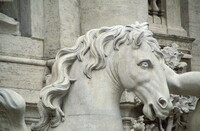Trevi Fountain
Salvi, Nicola

Download1A1-SN-TF-C5_cp.jpg (533.6Kb)
Alternative Title
Fontana di Trevi
Date
1732-1762Description
The figure of the east horse, profile view; Its construction was extremely protracted, but as early as 1735 the architectural framework was complete, and by Salvi's death the ornamental rock formations and full-scale models of most of the sculpture were in place. The fountain is the most monumental water display in Rome and represents the culmination of a tradition of combining water and sculpture within an elaborate architectural setting. Salvi treated an existing façade of the Palazzo Poli as a nine-bay unit with the central three bays articulated with attached Corinthian columns suggesting an antique triumphal arch. The central bay is treated as a giant niche, which frames Maini's free-standing figure of Oceanus, from which the sculptural scheme and the waters of the fountain seem to flow into a large rock basin. An attic storey above the central niche is surmounted by a coat of arms of Clement XII and incorporates statues representing the Four Seasons, part of a complex iconographic scheme emphasizing the important role of water in nature. Source: Grove Art Online; http://www.groveart.com/ (accessed 12/10/2007)
Type of Work
fountain; monumentSubject
allegorical, architectural exteriors, mythology (Classical), Architecture, Baroque, Fountains, Oceanus (Greek deity), Baroque
Rights
Rights Statement
Licensed for educational and research use by the MIT community only